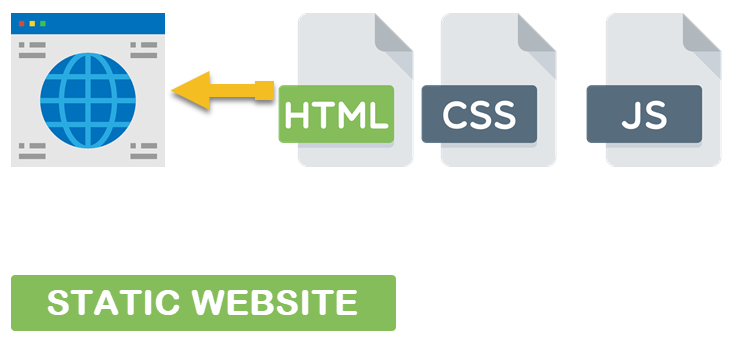In the realm of web development, where trends and technologies continually evolve, the concept of static sites has made an amazing reappearance. These lightweight websites have caught some eyeballs for their simplicity, speed, and security. In this blog post, we'll embark on a journey to demystify the world of static sites, exploring their definition, advantages, and practical applications. As a bonus, you'll get to know about some static site generators as well!
What is a Static Site?
In the era of dynamic content and interactive web applications, static sites may seem like a relic of the past. However, their simplicity and efficiency make them a valuable tool in the modern web development landscape. A static site consists of HTML, CSS, JavaScript, and other static files that are pre-rendered and delivered directly to the user's browser. Unlike dynamic sites, which generate content on the server in response to user requests, static sites present fixed content to the user, resulting in faster load times and enhanced security.
The Advantages
- Speed: Static sites excel in delivering swift browsing experiences since there is no need for server-side processing or database queries. With every page already rendered, users can enjoy minimal loading times.
- Security: Since static sites lack server-side code execution or database interactions, they pose a smaller attack surface and are inherently more secure. This reduced complexity reduces the risk of vulnerabilities and simplifies the task of protecting sensitive data.
- Scalability: Static sites can handle high traffic loads with ease, as they can be served through content delivery networks (CDNs). CDNs distribute website assets across multiple servers worldwide, ensuring quick access to content regardless of the user's geographic location.
- Cost-effectiveness: With no need for complex server infrastructure or dynamic frameworks, the cost of hosting and maintaining a static site is significantly lower. Hence, this makes static sites an attractive option for small businesses, personal portfolios, and blogs.
- Version Control: Static sites benefit from the simplicity of version control systems like Git. Developers can easily track changes, roll back to previous versions, and collaborate effectively, streamlining the development process.
Some security measures for static sites
- Secure Communication with SSL/TLS: One of the fundamental security measures for any website, including static sites, is to enable secure communication through the use of SSL/TLS certificates. By encrypting the data transmitted between the user's browser and the server, SSL/TLS ensures the confidentiality and integrity of sensitive information, such as login credentials and personal data.
- Protection against Common Attacks: Static sites can be further secured by implementing measures to protect against common web attacks, such as Cross-Site Scripting (XSS) and Cross-Site Request Forgery (CSRF). Proper input validation, output encoding, and adherence to security best practices help ensure the integrity and safety of user data.
- Content Security Policies (CSP): Implementing a Content Security Policy allows website owners to define the sources from which their site can load resources, such as scripts, stylesheets, and images. CSP helps prevent malicious code injection by restricting the execution of scripts from unauthorized sources, mitigating the risks associated with cross-site scripting attacks.
Some Practical Applications
- Blogs and Personal Websites: Static sites offer an ideal platform for bloggers and individuals seeking an easy and efficient way to showcase their work and portfolios.
- Documentation and Knowledge Bases: The simplicity and ease of maintenance make static sites an excellent choice for creating documentation or knowledge bases. Developers can focus on content creation, while users enjoy quick access to the information they seek.
- Landing Pages: Static sites are perfect for creating landing pages that require fast loading times and clear calls to action. These pages can help businesses capture leads and promote products.
- E-commerce: Though traditionally associated with dynamic sites, static site generators combined with API-driven services enable developers to build blazing-fast and secure e-commerce websites. This combination ensures a seamless user experience without compromising on functionality.
Static Site Generators: Enter Gatsby and More
One of the most popular static site generators is Gatsby. It harnesses the power of React, GraphQL, and modern web development tools to create lightning-fast static sites. With Gatsby, developers can leverage its extensive plugin ecosystem, which offers features such as image optimization, SEO, and content management systems integration. Gatsby's rich ecosystem and developer-friendly environment make it a top choice for building performant static sites.
Apart from Gatsby, there are several other renowned static site generators:
- Hugo: Known for its incredible speed and simplicity, Hugo is a static site generator written in Go. It boasts a robust templating system and a wide range of themes, making it ideal for blogs, portfolios, and documentation sites.
- Jekyll: Jekyll, powered by Ruby, is a popular static site generator favored by developers. It simplifies content management and provides a seamless integration with GitHub Pages.
- Next.js: While primarily designed for dynamic React applications, Next.js can be used as a static site generator. Its static site generation feature generates static HTML files during build time, enabling developers to create performant static sites effortlessly.
Conclusion
Static sites have reemerged as a powerful solution in web development, offering simplicity, speed, and enhanced security. The rise of static site generators like Gatsby, Hugo, Jekyll, and Next.js has revolutionized the way we create and deploy static sites. By leveraging the power of pre-rendered content, developers can craft engaging websites that captivate visitors without sacrificing performance. So, embrace the magic of static sites and the ease of static site generators, and embark on a journey to build remarkable online experiences that leave a lasting impression.
I hope you enjoyed this blog post and found it useful. Feel free to share your thoughts on this topic in the comments section below.







0 Comments